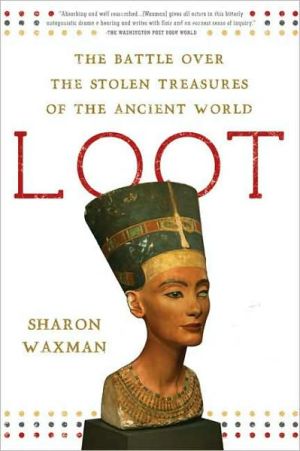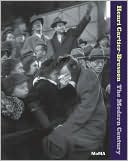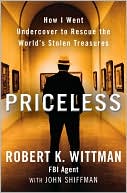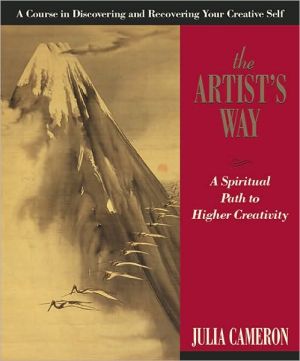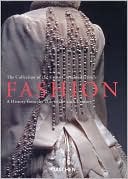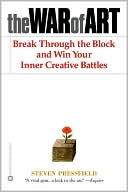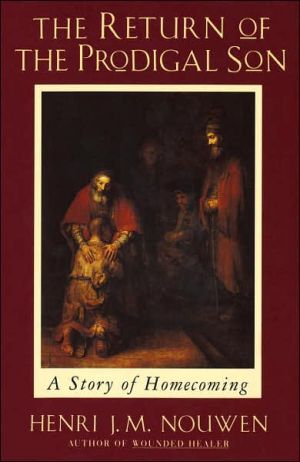Loot: The Battle over the Stolen Treasures of the Ancient World
“Fast-paced and compelling . . . Waxman has an array of wondrous tales to tell . . . Considerable, admirable, and totally absorbing.”—The Boston Globe\ For the past two centuries, the West has plundered the treasures of the ancient world to fill its great museums, but in recent years the countries where ancient civilizations originated have begun to push back, taking museums to court, prosecuting curators, and threatening to force the return of these priceless objects.\ Sharon Waxman brings...
Search in google:
“Fast-paced and compelling . . . Waxman has an array of wondrous tales to tell . . . Considerable, admirable, and totally absorbing.”—The Boston GlobeFor the past two centuries, the West has plundered the treasures of the ancient world to fill its great museums, but in recent years the countries where ancient civilizations originated have begun to push back, taking museums to court, prosecuting curators, and threatening to force the return of these priceless objects.Sharon Waxman brings us inside this high-stakes conflict, from the great cities of the West to Egypt, Turkey, Greece, and Italy, as these countries face down the Louvre, the Metropolitan Museum, the British Museum, and the J. Paul Getty Museum. She shows how the actions of a few determined and implacable characters may yet strip these museums of some of their most cherished treasures.For readers who are fascinated by antiquity, who love to frequent museums, and who believe in the value of cultural exchange, Loot opens a new window on an enduring conflict.The Washington Post - Roger Atwood…absorbing and well-researched …Although her views are often unnervingly one-sided (her sympathies lean toward letting museums keep their contested holdings), she gives all actors in this bitterly antagonistic drama a hearing and writes with flair and an earnest sense of inquiry.
\ INTRODUCTION \ It was just like Zahi Hawass to toss a bomb into the middle of someone else’s well-laid plans. On a bright, breezy day in June 2006, dozens of reporters and news crews, cameras, and microphones were lined up at the Field Museum in Chicago for a pleasant and entirely noncontroversial news event: the opening of an exhibit of the treasures of King Tutankhamun, on loan from Egypt for the first time since 1977.\ Sitting in the front row, Hawass, the charismatic secretary-general of Egypt’s Supreme Council of Antiquities, was braced for a fight. As he listened to remarks by Randy Mehrberg, a spokesman for the show’s corporate sponsor, a billion-dollar electricity corporation called Exelon, he felt himself grow increasingly incensed. Extolling the wonders of ancient Egypt, Mehrberg mentioned that Exelon’s CEO, JohnRowe, was an avid Egyptophile who kept the sarcophagus of a mummy in his office. Hawass, dapper in a suit and tie, wasted no time. He strode to the podium and went straight for the jugular. "No one has a right to have an artifact like that in their office or in their home," he declared indignantly, kicking the exhibit’s benefactor in the gut and stunning the museum’s officials. "How can he sponsor an exhibit like King Tut and keep an artifact like this in his office?" Rowe should surrender the sarcophagus to a museum, Hawass said, or send it back to Egypt. If he didn’t, there would be consequences. What kind of consequences? Hawass had plenty in mind. Never mind that the sarcophagus—a 2,200-year-old wooden coffin with painted designs and hieroglyphs—was Rowe’s private property. Never mind that it had been purchased legally from a reputable dealer. Never mind that Rowe ran one of the biggest utilities in the country and had been a major contributor to President George W. Bush, with whom he was touring power plants on the day of the museum news conference. In this case, none of that mattered. For the next two days, Hawass turned up the pressure; he threatened to pull out of the exhibit, and he warned that he would cut Egypt’s ties to the museum and its partners if Rowe didn’t relinquish the sarcophagus or withdraw Exelon’s sponsorship.\ Within the museum, panic ensued. The exhibit was about to open to an expected audience of 1 million visitors, and the story had taken up residence on the Chicago Tribune’s front page. By the end of day two, John Rowe blinked. He agreed to loan the piece—an artifact of middling value, not really worthy of the Field Museum’s galleries—indefinitely. You could practically hear the museum administration breathe a sigh of relief: "This has been a very, very happy resolution for everyone," said a spokeswoman. "We’re very pleased." Added an Exelon official, "John loves the Field Museum and is happy to share the piece." Hawass, atlas, was mollified. At a dinner for the opening that night, he was all charm and smiles. "Mr. Rowe is a very nice man," he said. "To accept that the coffin be given to the Field Museum, this will finish the process and make peace with everybody."\ Peace? How nice. A sharing kind of word. But peace and sharing are not at all what is in the air around museums these days, nor in the countries that were home to the great civilizations of the ancient world. Instead it has been lawsuits and criminal prosecution, public embarrassment, and bare-knuckled threats. Of late, it’s been much more\ like war, a tug-of-war over who should own the ancient artifacts that represent the heritage of humankind. Over the past two hundred years, antiquities and monuments have been ripped from the ground and shipped across the world, and many of these pieces now reside in the vast collections of the great museums of the West. Should they stay where they are—at the Louvre, the Metropolitan Museum of Art, the British Museum, and elsewhere—exhibited and preserved with care, accessible to avid crowds of visitors from around the world? Or should they return to their countries of origin, whose demands for restitution have grown ever more vociferous, a chorus of dissatisfaction from\ across the ancient world?\ In April 2007 Zahi Hawass announced that Egypt would seek the loan (though he has also said he seeks the permanent return) of five iconic pieces from museums in Europe and the United States, including the Rosetta Stone and the famed bust of Nefertiti, even as he raises hell over minor pieces such as John Rowe’s. With Greece preparing to open a modern museum at the base of the Acropolis in Athens, its government has renewed its demand for the return of the Elgin Marbles, the sculptures removed from the Parthenon in 1802 by the Earl of Elgin and kept at the British Museum. Italy has waged a sustained campaign against museums, dealers, and collectors for the return of artifacts it claims were illegally excavated and smuggled from the country. That culminated in the two-year criminal trial of the American curator Marion True and, in August 2007, in the agreement by True’s former employer, the J. Paul Getty Museum, to return forty artifacts from its permanent collection.\ Is this historic justice, the righting of ancient wrongs from the age of imperialism? Or is it a modern settling of scores by the frustrated leaders of less powerful nations? And why now, all of a sudden, has the issue taken hold with such force? The battle over ancient treasures is, at its base, a conflict over identity, and over the right to reclaim\ the objects that are its tangible symbols. At a time when East and West wage pitched battle over fundamental notions of identity (liberator or occupier; terrorist or freedom fighter), antiquities have become yet another weapon in this clash of cultures, another manifestation of the yawning divide. And ironically, it undermines the very purpose of\ cultural exchange, of building bridges and furthering mutual understanding.\ In some sense, the battle over antiquities is part of an epochal shift. Once upon a time, these objects were tied to the national identity of Western empires. From the sixteenth century forward, European culture became the dominant force in the world, sweeping across continents and destroying past civilizations, while claiming ancient history\ for itself. "Never before had one culture spread over the whole globe, "writes the historian J. M. Roberts. This cultural shift was a one-way process. "Europeans went out to the world, it did not come to them, "he adds. Except for the Turks, non-Europeans did not enter Europe. And after conquering foreign cultures, Europe brought back home the trophies that it desired, along with slaves, spices, treasure, and raw materials. The imperial age, beginning in the eighteenth century, culminated in the appropriation of ancient cultures for the glorification of European power. First, classical history—ancient Greece and Rome—were adopted as symbols of refinement and taste, their monuments sought and imitated in the battle for supremacy among competing empires. Then with the dawn of the nineteenth century and the rediscovery of ancient Egypt by Napoleon Bonaparte, mummies and pyramids were the new, must-have status symbols, and this fascination fueled the rise of scientific inquiry into the past. The uncovering of ancient\ Mesopotamia and its myriad civilizations followed in subsequent decades, with treasures and monuments brought to the halls of the Western cultural temple—the museum. The twentieth century expanded Western holdings to include the treasures of Asia, Latin America, and Africa.\ Today, we live in a different age. As once-colonized nations seek to stand on their own, the countries once denuded of their past seek to assert their independent identities through the objects that tie them to it. The demand for restitution is a way to reclaim history, to assert a moral imperative over those who were once overlords. Those countries still in the shadow of more powerful empires seek to claim the symbols of antiquity and colonialism to burnish their own national mythmaking.\ To those who love museums, who cherish history and are fascinated by antiquity, these arguments may seem strange. Who cares about national mythmaking? What about the artifacts themselves? Doesn’t the past belong to all of humanity? Aren’t museums there to exhibit the great achievements of art and human civilization? Well, yes. Of course.\ But as cultural politics change, museums change with them. Today museums must look hard at their missions and their guiding ethos. Western museums once could argue that they were necessary to protect ancient artifacts from being destroyed in the poor or unstable countries of their origin. In some cases—like Afghanistan or Iraq—this is still true, and Western museums remain essential custodians of the past. But many developing countries with ancient civilizations beneath their soil feel ready to step up and take full charge. Perhaps it is time to allow them to do so, and to return some or all of the artifacts to their care.\ For the better part of the past two centuries, this issue has lurked beneath the surface of the gleaming exhibits in the great cultural shrines of the West, untroubled by public discussion. I used to wonder: Do only ignorant laypeople gaze on the colossal bust of Ramses II at the British Museum and ask themselves how it ended up there? Is it only the unschooled visitor who looks at the soaring column from the Temple of Artemis at the Met and questions why it exists in this place? As a student, I visited the glorious Pergamum Museum in Berlin with its Altar of Zeus and marveled at its beauty, while wondering why an entire building from central Anatolia in Turkey had ended up there.(And for that matter, how did Egyptian obelisks find their way to plazas at the Vatican and in central Paris?) Amazingly, in almost no cases do the museums volunteer the information. They are veritable black holes when it comes to illuminating the nineteenth- and twentieth century histories of the ancient objects that they shelter.\ Still, the debate over the Elgin Marbles has raged publicly for nearly two hundred years, stoking the flames of nationalism on either side. The trustees of the British Museum have continually dismissed the requestor successive Greek governments for one overriding reason: precedent. If the British Museum were to give up the Elgin Marbles, its trustees fear, museums would soon be emptied of their ancient treasures. Thievery fear partly drove the museum to cover up its own mistakes in caring for the sculptures in the 1930s. It is a fear that permeates the world of museums today, with increasing legitimacy.\ The modern restitution question first arose in the 1970s, as archaeologists, enterprising journalists, and public officials realized that looting was not a thing of the past. The growing market in the West for antiquities as vast and varied as Cycladic sculpture, Mayan steal, Buddhist temple carvings, and Greek vases was fueling rampant destruction of archaeological sites in places as far afield as Guatemala, Costa Rica, Cambodia, Greece, Italy, and Turkey. The hunger for ancient beauty was destroying history, and Western museums were contributing to this loss of knowledge by feeding demand for the objects. In his landmark 1973 book The Plundered Past, the journalist Karl Meyer brought up most of the issues, and at least a few of the case studies, that still define the problem today: collusion among museums and antiquity dealers; the failure to demand proper provenances for the acquired artwork; the winking and nodding as dubious provenances are accepted as valid; the chain of actors in the process of smuggled antiquities, from the tomb robbers to the anonymous middlemen to the restorers to the upscale dealers, who collaborate with auction houses or sell to wealthy collectors; the lack of clear international laws to regulate\ all of this.\ But the world has evolved over the past three decades, as public awareness has grown more sensitive to the issue of cultural differences of all kinds, including the notion of cultural plunder. In 1970,UNESCO—the educational, scientific, and cultural arm of the United Nations—adopted a convention banning the illegal export and transferor cultural property, a convention adopted by many countries in order to stop the smuggling of contraband antiquities. The United States signed on in 1983. The rising culture of political correctness has served to tweak the conscience of many in the archaeological and museum worlds over demands for restitution, with some in these camps eager themselves to expiate the sins of the nineteenth and twentieth century’s. Meanwhile, restitution of stolen art was a topic that was coming into its own. In the late 1980s and early 1990s, survivors of the Holocaust and their heirs became bold in demanding the return of paintings and other artworks that had been confiscated by the Nazis during World War II. Some of those paintings had ended up in national museums in Austria, France, the Netherlands, or the United States, or were in the hands of private collectors willing to acquire works with suspiciously thin provenances. The ownership was successfully challenged in lawsuits and received widespread discussion in the press. Paintings were removed from museum galleries and presented to descendants of the persecuted in a bid to offer some justice for murdered victims. Countries that had been plundered of their antiquities took note.\ And finally, global politics have played a role. The shift in the world after 9/11 has contributed to the rise of restitution as a political hot button. East and West are divided not only in their worldviews but in their cultural perspectives. The rift between powerful and powerless is expressed not only in the violence of suicide bombs but also in strained exchanges over objects of ancient beauty. A reaction to American political and military supremacy can be felt in the restitution battles, just as the vestiges of anger over European colonialism are evident in the conflict. Similarly, the responses of the Western nations have often betrayed an arrogance that has served to stoke the flames of resentment over trampled national dignity.\ But there are no easy answers here. No clear right and wrong as there was in the case of looted Nazi art. Context matters. Details matter. The broad brushstrokes of polemic end up distorting the picture rather than clarifying it. For one thing, it must be asked: is it fair to view events that date back two hundred years through modern eyes? Is\ it appropriate to use words such as stolen and plundered for things taken when archaeology was in its infancy, and when pioneering explorers did what they believed was best? Looting, after all, did not begin two hundred years ago. Grave robbing is almost as old as the tombs of the pharaohs themselves. It is only in our modern age that the notion of "spoils of war" has taken on a negative connotation; this was once a reasonable outcome in the wake of hostilities. And for those interested unbalancing the scales of justice, where does it end? The ancient Romans stole obelisks from Egypt, to which Renaissance sculptors added their own adornments. Should these be dismantled to return the obelisks to Egypt? Should the four bronze horses on the roof of the church of San Marco in Venice be returned to Constantinople, whence they were taken in 1204 during the Fourth Crusade? Or should they be returned to Rome, since they supposedly adorned the Arch of Trajan before they were carted off to Constantinople? Or should they go back to the Greeks, who are believed to have originally made them in the fourth century BC? Those who would unravel the tangled skein of history will quickly confront such riddles. As the restitution debate evolves, new brain twisters emerge. Like this one: in 2007 American deep-sea explorers in international waters off the coast of Spain found a Spanish galleon that had been sunk by a British warship in 1804. On the ship, the explorers found gold and other treasures worth $500 million.\ Claiming that this was its "cultural heritage," Spain immediately asserted ownership of the shipwreck and filed a federal lawsuit in Tampa, Florida, to press its claim. But Peru then intervened to ask what seemed to be a relevant question: wasn’t this gold stolen from the Peruvians’ Incan forebears? And if so, shouldn’t they be the ones to whom restitutions made?\ It is possible that at the end of this journey, the reader will find more good questions than good answers. The subject tends to bring out hyperbole among right-minded activists, and even the most nobly intentioned observers can be wrong. In 1973 Karl Meyer wrote in the introduction to The Plundered Past, "Given the present tempo of destruction, by the end of the century all unexplored major archeological sites may be irrevocably disfigured or ravaged. We are witnessing the equivalent of the burning of the library at Alexandria by the Romans, the catastrophic bonfire in which much of the wisdom of antiquity was consumed in flames." Well, no; rampant smuggling continued\ through the end of the century, but somehow archaeological sites still exist. There is posturing and counter posturing on every side. There are lies and distortions and prevarications by the most solemn authorities and institutions, all in the service of making the argument that suits them best. Museums are expert at selective history. Until recently, it has been sufficient to state that Europeans were out to save the crumbling, neglected, and vandalized monuments of Egypt; that they were rescuing the Parthenon sculptures from savages like the Turks and inventing modern archaeology as they went; that American museums were buying artifacts that would otherwise disappear from public\ view. Those arguments cannot stand the test of contradictory facts: the evidence of nationalism and greed that fueled the collection of antiquities; the blind eye turned by curators and museum officials tithe provenance of artifacts that they knew well enough were probably looted.\ At the same time, the countries that demand restitution must face some serious facts of their own: museums in their countries are woefully underfunded and disorganized. Proper crating and even basic inventories are often nonexistent. In many cases the countries are not capable of securing the monuments and treasures that are already under their control. Corruption may be rife; artifacts may be stolen; looting continues. And what’s more, across the ancient world, museums are often empty of visitors. The rhetoric of source countries is often many years ahead of their abilities to effectively protect antiquities and disconnected from the interest of the local population.\ For the purposes of addressing so vast a subject, I focused on those countries that have aggressively pursued demands for restitution of antiquities: Egypt, Turkey, Greece, and Italy. In parallel, I focused on the major museums of the West whose antiquities collections have been called into question and which have faced the most high-profile restitution requests: the Louvre, the Metropolitan Museum of Art, the British Museum, and the J. Paul Getty Museum. In travel through dozen cities in eight countries, in scores of interviews and many hours of research, I have sought to get at the truth behind the accusations and claims made by museums and source countries—not as an art historian or archaeologist, but as a journalist with a passion for foreign cultures of all kinds and a love for the museums that first kindled that passion.\ The issues raised in these conflicts illuminate the broader themes that affect cultural exchange around the world. How did we get to this crossroads, and how do we proceed from here? The answers may note simple but they are critical to the survival of the artifacts that represent our common human heritage.\ Excerpted from Loot by Sharon Waxman\ Copyright 2009 by Sharon Waxman\ Published in September 2009 by Macmillan\ All rights reserved. This work is protected under copyright laws and reproduction is strictly prohibited. Permission to reproduce the material in any manner or medium must be secured from the Publisher.
\ From the Publisher“Sharon Waxman has written a compelling page turner about the world of antiquities and art-world skulduggery. She manages to combine rigorous, scholarly reporting with a flair for intrigue and personality that gives Loot the fast pace of a novel. I enjoyed it immensely."—Tina Brown\ "Loot is a riveting foray into the biggest question facing museums today: who should own the great works of ancient art? Sharon Waxman is a first-rate reporter, a veritable Euphronios of words, who not only explores the legal and moral ambiguities of the conflict but brings to life the colorful -- even outrageous -- personalities facing off for a high noon showdown over some of the world’s iconic works of art. Vivid, witty, and delightful, this book will beguile any reader with an interest in art and museums."—Douglas Preston, author of The Monster of Florence\ “Sharon Waxman’s Loot is the most instructive as well as the most intelligent (and the most entertaining) guide through the labyrinth of antiquity and the ways in which the claims of the departed intersect with the rights of the living.”—Christopher Hitchens author of God Is Not Great and The Elgin Marbles: Should They Be Returned to Greece?\ “Sharon Waxman approaches her subject with the passion of a great journalist and the rigor of a scholar. It may never again be possible for some of us to walk down the halls of the Louvre or the British Museum or the Metropolitan without a vague sense of disquietude, a frisson of wonder about the provenance of some of their showcase works of ancient art.”—Lucette Lagnado, author of The Man in the White Sharkskin Suit\ Sharon Waxman’s Loot is indispensable for everyone concerned with the illicit trade in smuggled antiquities. She exposes the self-serving humbug that too often afflicts both affluent possessors and righteous nationalists and shows that we all have a stake in getting an honest account of how great objects came to rest in our grandest museums."—Karl E. Meyer, author of The Plundered Past and co-author of Kingmakers: The Invention of the Modern Middle East\ "Fast-paced and compelling….Waxman has an array of wondrous tales to tell….Considerable, admirable, and totally absorbing."The Boston Globe\ \ "Loot is hip to the politics underlying the whole repatriation craze. . . . This book’s title is absolutely true."—Newark Star-Ledger\ \ "A journalistic tour de force -- an exhaustively researched, even-handed compendium of the disputes roiling museums and source countries."—CultureGrrl art blog\ "[An] insightful new exploration into cultural plunder."—Dallas Morning News\ \ "A measured, detailed and accessible history of cultural custody cases, bringing the ages-old quandary up to date."—Kansas City Star\ "Absorbing and well-researched . . . [Waxman] gives all actors in this bitterly antagonistic drama a hearing and writes with flair and an earnest sense of inquiry."—The Washington Post Book World\ "A remarkable book . . . After reading [Loot] you will never again view an antiquity in a museum in the same light."—Kings Features Syndicate\ "Loot does an excellent job of exploring the political underpinnings of the contest over antiquities…[Waxman’s] critical distance allows her to see both sides of this tangled story. . . Loot is an engaging and informative read."—Art + Auction Magazine\ "Lively and wide-ranging. . . Waxman has written the definitive volume."—ARTnews Magazine\ "Skillfully blending history and reportage . . . Waxman’s account is animated by interviews with museum curators, accused smugglers and government officials, putting a human spin on the complex cultural politics before arriving at a middle ground that strives for international collaboration in preserving a broad global heritage."—Publishers Weekly, starred review\ "Former New York Times culture correspondent [Sharon] Waxman adroitly and expertly explores a centuries-old struggle . . . In Waxman’s hands, the question of justice remains intriguingly slippery, and the argument over who owns history takes on new depth. Erudite and wholly satisfying."—Kirkus Reviews\ "Exposes hypocrisy on all sides of the debates."—The Roanoke Times\ "Comprehensive and revealing . . . Waxman is a congenial, globe-hopping tour guide through cramped offices, dank tomb sites, and sleek, art-filled palaces."—Booklist\ "[An] intelligent, well-informed book . . . [Waxman] skillfully interweaves lucid historical accounts with savvy contemporary interviews. . . . This wide-ranging narrative limns a multifaceted problem with no single solution. Facing facts would be a good place to start, Waxman concludes."--Los Angeles Times\ "Waxman, a former correspondent for the New York Times, recounts tales of arrogance, greed and lust in museum personnel who, however well educated, are all too human in their daily affairs. . . . The questions Waxman raises are real, and her proposals to remedy the situation are the start of a much-needed discussion."--San Francisco Chronicle Book Review\ "Waxman illustrates this overstuffed book with the colorful personalities and histories behind some of the most famous ancient artworks (the Elgin Marbles, the Rosetta Stone), and the questions she raises are fascinating ones...Loot contains its share of golden treasures underneath all that dust."--Gilbert Cruz, Time "Loot ... is a timely account of how the world ofantiquities arrived at the situation it is in today ... an engaging and informative read." --Andrew Slayman, ArtInfo.com\ \ \ \ \ \ Roger Atwood…absorbing and well-researched …Although her views are often unnervingly one-sided (her sympathies lean toward letting museums keep their contested holdings), she gives all actors in this bitterly antagonistic drama a hearing and writes with flair and an earnest sense of inquiry.\ —The Washington Post\ \ \ Publishers WeeklyAfter covering Hollywood's cutting-edge directors (Rebels on the Backlot), former New York Times correspondent Waxman embarks on a grand tour of some of the world's finest museums-the Met, the Louvre, the British Museum, the Getty-and the countries from which some of their most famous antiquities were illicitly taken. Skillfully blending history and reportage, Waxman traces the stories of treasures like the Elgin Marbles, then jumps into the debate over whether they should be restored to their countries of origin. She finds no easy answers: while acknowledging the dubious means by which European and American museums acquired many antiquities, she concedes that the governments clamoring for their return don't always have adequate plans for their maintenance. (Turkey compelled the Met to hand over the famous Lydian Hoard, only to have its masterpiece stolen.) Waxman's account is animated by interviews with museum curators, accused smugglers and government officials, putting a human spin on the complex cultural politics before arriving at a middle ground that strives for international collaboration in preserving a broad, global heritage. 8-page color insert, 20 b&w photos. (Nov. 1)\ Copyright © Reed Business Information, a division of Reed Elsevier Inc. All rights reserved.\ \ \ \ \ Kirkus ReviewsFormer New York Times culture correspondent Waxman (Rebels on the Backlot: Six Maverick Directors and How They Conquered the Hollywood Studio System, 2005) adroitly and expertly explores a centuries-old struggle. The British Museum in London contains some of the finest examples of classical Greek sculpture ever seen. Known as the Elgin marbles, they consist of friezes, statuary and architectural elements removed from the Parthenon in 1801 by a British nobleman. These spectacular marbles, the author notes, are among the most hotly contested items in a battle over repatriation of looted artifacts that rages all over the world. From the conflict between Cairo and Berlin over a exquisite bust of Nefertiti to Turkey's successful reclamation of the "Lydian Horde" illegally excavated and sold to the Met, Waxman covers multiple dramatic stories of feuds over riches from the world's ancient civilizations. Often cast as a struggle between former colonizers and colonies, with repatriation seen as a form of amends for generations of domination, the debate has more complexity in this presentation. The author presents multiples points of view. The almost invariably impoverished countries of origin, their representatives argue, had no choice but to allow excavations authorized by their colonial rulers. On the other hand, contend contemporary museum curators who fervently believe in the ideal of a "universal" museum bringing together many cultures, the nations demanding the return of these artifacts often do not have the resources to preserve them. Who has the right to the world's treasures? The case of the Elgin marbles illustrates how difficult such questions are to answer. Much of the Parthenon wasdestroyed during the marbles' removal, but the temple was being used at the time by the occupying Turks as a storage facility for gun powder, with more than one resulting explosion. Athenian pollution subsequently corroded much of what remained on site, but the British Museum's attempts to clean the marbles has also had disastrous effects. In Waxman's hands, the question of justice remains intriguingly slippery, and the argument over who owns history takes on new depth. Erudite and wholly satisfying. Agent: Andrew Blauner/Blauner Books Literary Agency\ \
